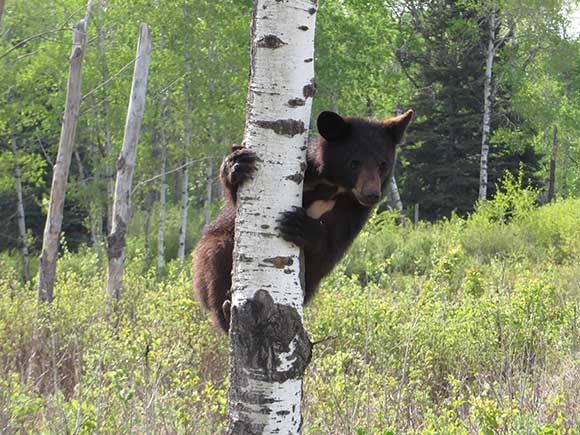Black Bears: Fact or Fiction?
Riding Mountain National Park
How much do you know about black bears in RMNP? Test your knowledge in our quiz below!
Fact or fiction?
1) Even though “black” is right in their name, black bears can have fur in a wide range of colours.

2) It’s easy to estimate the exact number of bears in the park through traditional methods of counting.

3) RMNP is thought to have one of the highest concentrations of black bears in Canada.

4) Bears found in RMNP are above average in size, some even larger than adult male grizzly bears in the Rocky Mountains.

5) Black bears are mostly herbivores.

1) FACT: Fur colours can range from black, brown, reddish (cinnamon), blonde, and a combination of all colours. The colours can vary from year to year and over the summer season. The thought is that black bears live in various habitats so they evolved to have a coat colouration that will suit those environs.

2) FICTION: Bears are out of the dens in the summer when they would be countable. Doing traditional counts, from the air, is not possible due to leaf cover and the fact that bears blend into the surroundings so well. Possible methods for getting a possible population estimate is through genetics research or a possible wildlife camera study (getting an index of the population and seeing if it changes over the years). We currently use an estimate based on the available habitat types and use methods from other jurisdictions that have done the work to determine the population.

3) WE AREN’T SURE: It is possible because RMNP has a lot of suitable habitat and food sources. Unfortunately, we have never been able to do an actual count for the reasons mentioned above.

4) FICTION: An especially large bear, nicknamed Duke, weighed 807 pounds when captured for a study in 1987. He was the largest black bear ever measured at the time and it was thought that bears in RMNP were above average in size, considering this one was larger than some adult male grizzly bears. However, this bear was an anomaly, and was fed in the garbage dump that was present in the park at the time. Black bears that feed from artificial food sources such as garbage dumps or refuse sites can get much larger than ones who rely on natural food sources in the wild. Further observation in the following years found that black bears in RMNP are about the same size as ones found elsewhere.

5) FACT: Black bears are indeed mostly herbivores. Some of their favourite foods include grass, dandelions, ants, various berries, and whatever is in season. In calving season, they will hunt newborn animals. They will also feed on wolf-kill or winter-kill carcasses. It is important that bears rely only on natural food sources. Bears can lose their fear of humans when they are attracted to inappropriate food sources such as coolers, bird feeders, barbecues, pet food, garbage and recycling. We urge you to secure all wildlife attractants in order to deter unwanted visits.

- Date modified :
